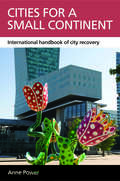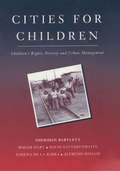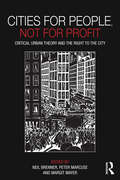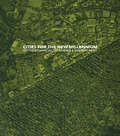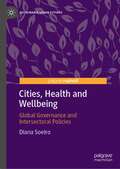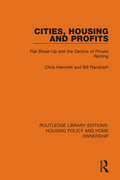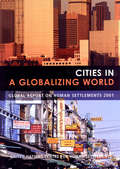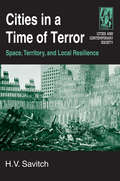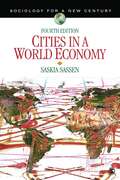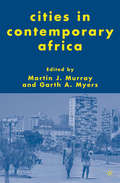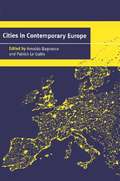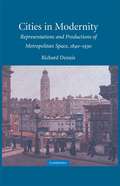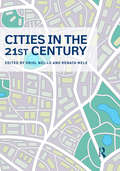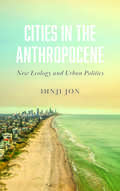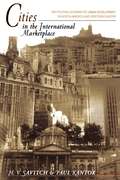- Table View
- List View
Cities for a small continent: International handbook of city recovery (CASE Studies on Poverty, Place and Policy)
by Anne PowerThis original book builds on the author’s research in Phoenix cities to present a vivid story of Europe’s post-industrial cities pre- and post- financial crisis. Using varied case studies the book explores how policy responses to the economic crisis have played out in different European cities, with their contrasting conditions, history and performance generating contrasting reactions. The book compares changes between Northern and Southern European countries, bigger and smaller cities, over the past ten years. Across the continent social cohesion, community investment and social enterprise have gained momentum as Europe’s crowded, resource-constrained cities face up to environmental and social limits faster than other less densely urban countries, such as the US. The author presents a compelling framework to show that Europe’s cities are creating a new industrial economy to combat environmental and social unravelling.
Cities for a small continent: International handbook of city recovery (CASE Studies on Poverty, Place and Policy)
by Anne PowerThis original book builds on the author’s research in Phoenix cities to present a vivid story of Europe’s post-industrial cities pre- and post- financial crisis. Using varied case studies the book explores how policy responses to the economic crisis have played out in different European cities, with their contrasting conditions, history and performance generating contrasting reactions. The book compares changes between Northern and Southern European countries, bigger and smaller cities, over the past ten years. Across the continent social cohesion, community investment and social enterprise have gained momentum as Europe’s crowded, resource-constrained cities face up to environmental and social limits faster than other less densely urban countries, such as the US. The author presents a compelling framework to show that Europe’s cities are creating a new industrial economy to combat environmental and social unravelling.
Cities for Children: Children's Rights, Poverty and Urban Management
by Roger Hart David Satterthwaite Sheridan Bartlett Ximena de Barra Alfredo MissairUrban authorities and organizations are responsible for providing the basic services that affect the lives of urban children. Cities for Children is intended to help them understand and respond to the rights and requirements of children and adolescents. It looks at the responsibilities that authorities face, and discusses practical measures for meeting their obligations in the context of limited resources and multiple demands. While the book emphasizes the challenges faced by local government, it also contains information that would be useful to any groups working to make urban areas better places for children. Cities for Children begins by introducing the concept, history and content of children's rights and the obligations they create for local authorities. The volume then goes on to look at a variety of contentious issues such as housing, community participation, working children, community health, education and juvenile justice. The final section of the book discusses the challenge of establishing systems of governance that can promote the economic security, social justice and environmental care essential for the realization of children's rights. It follows through the practical implications for the structure, policies and practices of local authorities. Written by the top experts in the field of children's issues, and including a resource section which lists publications and organizations that can provide further information and support, this volume is a must for all involved in planning for, and the protection of, children within the urban environment.
Cities for Children: Children's Rights, Poverty and Urban Management
by Roger Hart David Satterthwaite Sheridan Bartlett Ximena de Barra Alfredo MissairUrban authorities and organizations are responsible for providing the basic services that affect the lives of urban children. Cities for Children is intended to help them understand and respond to the rights and requirements of children and adolescents. It looks at the responsibilities that authorities face, and discusses practical measures for meeting their obligations in the context of limited resources and multiple demands. While the book emphasizes the challenges faced by local government, it also contains information that would be useful to any groups working to make urban areas better places for children. Cities for Children begins by introducing the concept, history and content of children's rights and the obligations they create for local authorities. The volume then goes on to look at a variety of contentious issues such as housing, community participation, working children, community health, education and juvenile justice. The final section of the book discusses the challenge of establishing systems of governance that can promote the economic security, social justice and environmental care essential for the realization of children's rights. It follows through the practical implications for the structure, policies and practices of local authorities. Written by the top experts in the field of children's issues, and including a resource section which lists publications and organizations that can provide further information and support, this volume is a must for all involved in planning for, and the protection of, children within the urban environment.
Cities for People, Not for Profit: Critical Urban Theory and the Right to the City
by Neil Brenner Peter Marcuse Margit MayerThe worldwide financial crisis has sent shock-waves of accelerated economic restructuring, regulatory reorganization and sociopolitical conflict through cities around the world. It has also given new impetus to the struggles of urban social movements emphasizing the injustice, destructiveness and unsustainability of capitalist forms of urbanization. This book contributes analyses intended to be useful for efforts to roll back contemporary profit-based forms of urbanization, and to promote alternative, radically democratic and sustainable forms of urbanism. The contributors provide cutting-edge analyses of contemporary urban restructuring, including the issues of neoliberalization, gentrification, colonization, "creative" cities, architecture and political power, sub-prime mortgage foreclosures and the ongoing struggles of "right to the city" movements. At the same time, the book explores the diverse interpretive frameworks – critical and otherwise – that are currently being used in academic discourse, in political struggles, and in everyday life to decipher contemporary urban transformations and contestations. The slogan, "cities for people, not for profit," sets into stark relief what the contributors view as a central political question involved in efforts, at once theoretical and practical, to address the global urban crises of our time. Drawing upon European and North American scholarship in sociology, politics, geography, urban planning and urban design, the book provides useful insights and perspectives for citizens, activists and intellectuals interested in exploring alternatives to contemporary forms of capitalist urbanization.
Cities for People, Not for Profit: Critical Urban Theory and the Right to the City
by Neil Brenner Peter Marcuse Margit MayerThe worldwide financial crisis has sent shock-waves of accelerated economic restructuring, regulatory reorganization and sociopolitical conflict through cities around the world. It has also given new impetus to the struggles of urban social movements emphasizing the injustice, destructiveness and unsustainability of capitalist forms of urbanization. This book contributes analyses intended to be useful for efforts to roll back contemporary profit-based forms of urbanization, and to promote alternative, radically democratic and sustainable forms of urbanism. The contributors provide cutting-edge analyses of contemporary urban restructuring, including the issues of neoliberalization, gentrification, colonization, "creative" cities, architecture and political power, sub-prime mortgage foreclosures and the ongoing struggles of "right to the city" movements. At the same time, the book explores the diverse interpretive frameworks – critical and otherwise – that are currently being used in academic discourse, in political struggles, and in everyday life to decipher contemporary urban transformations and contestations. The slogan, "cities for people, not for profit," sets into stark relief what the contributors view as a central political question involved in efforts, at once theoretical and practical, to address the global urban crises of our time. Drawing upon European and North American scholarship in sociology, politics, geography, urban planning and urban design, the book provides useful insights and perspectives for citizens, activists and intellectuals interested in exploring alternatives to contemporary forms of capitalist urbanization.
Cities for the New Millennium
by Marcial Echenique Andrew SaintCities for the New Millennium is the outcome of a joint conference held in Salford in July 2000 by the Royal Institute of British Architects and the University of Cambridge's Department of Architecture. It tackles these questions in the light of the Urban Task Force's report about the future of Britain's cities and communities, but sets them in an international and historical context. Professionals - architects, engineers and developers as well as academics from different countries and disciplines here lavish their expertise on issues of transportation, density, land use, risk and energy saving; others present urban-scale buildings or landscapes that have been judged inspirational or inventive. This book, therefore, is not just about theories of urbanism. It reveals how co-operation and debate between different parties and professions can illuminate the creative kind of urban development we should be aiming for.
Cities for the New Millennium
by Andrew Saint Marcial EcheniqueCities for the New Millennium is the outcome of a joint conference held in Salford in July 2000 by the Royal Institute of British Architects and the University of Cambridge's Department of Architecture. It tackles these questions in the light of the Urban Task Force's report about the future of Britain's cities and communities, but sets them in an international and historical context. Professionals - architects, engineers and developers as well as academics from different countries and disciplines here lavish their expertise on issues of transportation, density, land use, risk and energy saving; others present urban-scale buildings or landscapes that have been judged inspirational or inventive. This book, therefore, is not just about theories of urbanism. It reveals how co-operation and debate between different parties and professions can illuminate the creative kind of urban development we should be aiming for.
Cities, Health and Wellbeing: Global Governance and Intersectoral Policies (Sustainable Urban Futures)
by Diana SoeiroOn 25 September 2015, the United Nations General Assembly unanimously adopted Resolution 70/1, “Transforming our World: the 2030 Agenda for Sustainable Development”. Also known as 2030 Agenda, the document lays out 17 Sustainable Development Goals (SDGs) in the realm of ecology, society and economy. The current book focuses on three of these goals: SDG 16: Peace, Justice and Strong Institutions; SDG 3: Health and Wellbeing; SDG 11: Cities and Sustainable Communities. It is critical that interdisciplinary approaches go one step further and translate more effectively into intersectoral policies. This is particularly vital when it comes to urban planning and health. This book address the key question: In the context of a growing influence of European Union policies at a national level, can SDGs simultaneously contribute to harmonising sectoral policies and promoting intersectoral policies? Claiming a growing convergence between health and spatial planning, the main goal of the book is to formulate an answer to the following question: how can policymakers translate the SDGs effectively into public policies in order to improve cities, health and wellbeing?
Cities, Housing and Profits: Flat Break-Up and the Decline of Private Renting
by Chris Hamnett Bill RandolphOriginally published in 1988, this book documents and explains the emergence of flat ‘break-ups’ – the sale of individual owner occupation of blocks of flats which were previously privately rented and which played a major role in the transformation of the private housing market in London since the 1960s. The book shows that the flat break-up market in London was not a unique phenomenon but one of the most geographically concentrated manifestations of the trend for sales from private renting to owner occupation which has been established in the UK since the 1920s. The interrelationship between the causes of the decline of the privately rented sector in Britain and the features specific to the flat market comprises the second theme of the book.
Cities, Housing and Profits: Flat Break-Up and the Decline of Private Renting
by Chris Hamnett Bill RandolphOriginally published in 1988, this book documents and explains the emergence of flat ‘break-ups’ – the sale of individual owner occupation of blocks of flats which were previously privately rented and which played a major role in the transformation of the private housing market in London since the 1960s. The book shows that the flat break-up market in London was not a unique phenomenon but one of the most geographically concentrated manifestations of the trend for sales from private renting to owner occupation which has been established in the UK since the 1920s. The interrelationship between the causes of the decline of the privately rented sector in Britain and the features specific to the flat market comprises the second theme of the book.
Cities in a Globalizing World: Global Report on Human Settlements
by Un-Habitat'The world has entered the urban millennium. Nearly half the world's people are now city dwellers, and the rapid increase in urban population is expected to continue, mainly in developing countries. This historic transition is being further propelled by the powerful forces of globalization. The central challenge for the international community is clear: to make both urbanization and globalization work for all people, instead of leaving billions behind or on the margins. Cities in a Globalizing World: Global Report on Human Settlements is a comprehensive review of conditions in the world's cities and the prospects for making them better, safer places to live in an age of globalization. I hope that it will provide all stakeholders - foremost among them the urban poor themselves - with reliable and timely information with which to set our policies right and get the machinery of urban life moving in a constructive direction.' From the Foreword by Kofi Annan, Secretary-General, United Nations. Cities in a Globalizing World presents a comprehensive review of the world's cities and analyses the positive and negative impacts on human settlements of the global trends towards social and economic integration and the rapid changes in information and communication technologies. In this Global Report, the United Nations Centre for Human Settlements (Habitat) draws on specially commissioned and contributed background papers from more than 80 leading international specialists. The report focuses on recent trends in human settlements and their implications for poverty, inequity and social polarization. It develops advance knowledge for urban planning and management policies in support and promotion of inclusive cities and good urban governance. This major and influential report is the most authoritative and up-to-date assessment of human settlements conditions and trends. Written in clear, non-technical language and supported by informative graphics, case studies and extensive statistical data, it should be an essential tool and reference for academics, researchers, planners, public authorities and civil society organizations around the world.
Cities in a Globalizing World: Global Report on Human Settlements
by Un-Habitat'The world has entered the urban millennium. Nearly half the world's people are now city dwellers, and the rapid increase in urban population is expected to continue, mainly in developing countries. This historic transition is being further propelled by the powerful forces of globalization. The central challenge for the international community is clear: to make both urbanization and globalization work for all people, instead of leaving billions behind or on the margins. Cities in a Globalizing World: Global Report on Human Settlements is a comprehensive review of conditions in the world's cities and the prospects for making them better, safer places to live in an age of globalization. I hope that it will provide all stakeholders - foremost among them the urban poor themselves - with reliable and timely information with which to set our policies right and get the machinery of urban life moving in a constructive direction.' From the Foreword by Kofi Annan, Secretary-General, United Nations. Cities in a Globalizing World presents a comprehensive review of the world's cities and analyses the positive and negative impacts on human settlements of the global trends towards social and economic integration and the rapid changes in information and communication technologies. In this Global Report, the United Nations Centre for Human Settlements (Habitat) draws on specially commissioned and contributed background papers from more than 80 leading international specialists. The report focuses on recent trends in human settlements and their implications for poverty, inequity and social polarization. It develops advance knowledge for urban planning and management policies in support and promotion of inclusive cities and good urban governance. This major and influential report is the most authoritative and up-to-date assessment of human settlements conditions and trends. Written in clear, non-technical language and supported by informative graphics, case studies and extensive statistical data, it should be an essential tool and reference for academics, researchers, planners, public authorities and civil society organizations around the world.
Cities in a Time of Terror: Space, Territory, and Local Resilience
by H.V. SavitchThis book is about urban terror - its meaning, its ramifications, and its impact on city life. Written by a well-known expert in the field, "Cities in a Time of Terror" draws on data from more than a thousand cities across the globe and traces the evolution of urban terrorism between 1968 and 2006. It explains what kinds of cities have become prime targets, why terrorism has become increasingly lethal, and how its inspiration has changed from secular to religious. The author describes urban terrorism as an attempt to use the city's own strength against itself, forcing it to implode, and delineates three basic logics of terrorist choices for targeting cities. The book also includes a discussion of local resilience - the city's capacity to bounce back from attack - and suggests how that can be sustained. Examples from New York, London, Jerusalem, Istanbul, Moscow, Paris, and Madrid illustrate the book's central themes.
Cities in a Time of Terror: Space, Territory, and Local Resilience (Cities And Contemporary Society Ser.)
by H.V. SavitchThis book is about urban terror - its meaning, its ramifications, and its impact on city life. Written by a well-known expert in the field, "Cities in a Time of Terror" draws on data from more than a thousand cities across the globe and traces the evolution of urban terrorism between 1968 and 2006. It explains what kinds of cities have become prime targets, why terrorism has become increasingly lethal, and how its inspiration has changed from secular to religious. The author describes urban terrorism as an attempt to use the city's own strength against itself, forcing it to implode, and delineates three basic logics of terrorist choices for targeting cities. The book also includes a discussion of local resilience - the city's capacity to bounce back from attack - and suggests how that can be sustained. Examples from New York, London, Jerusalem, Istanbul, Moscow, Paris, and Madrid illustrate the book's central themes.
Cities in a World Economy (PDF)
by Saskia SassenThe Fourth Edition of Cities in a World Economy shows how certain characteristics of our turn-of-the-millennium flows of money, information and people have led to the emergence of a new social formation: global cities. These developments give new meaning to such fixtures of urban sociology as the centrality of place and the importance of geography in our social world.
Cities in Contemporary Africa
by M. Murray G. MyersThis book explains how and why cities on the African continent have grown at such a rapid pace, how municipal authorities have tried to cope with this massive influx of people, and how long-time urban residents and newcomers interact, negotiate, and struggle over access to limited resources.
Cities in Contemporary Europe (PDF)
by Arnaldo Bagnasco Patrick Le Gale`sEuropean cities are at the centre of social, political and economic changes in Western Europe. This book proposes a new research agenda in urban sociology and politics applying primarily to European cities, in particular those that together make up the urban structure of Europe: a fabric of older cities of over 100,000 inhabitants, regional capitals and smaller state capitals. The contributors develop an analytical framework which views cities as local societies, and as collective actors and sites for modes of governance. The book examines the economics of cities, their social structures, and the modes and processes of governance. Each chapter comprises a comparison across several countries and critically examines the book’s central theoretical perspective. This is not a book about the making of a Europe of cities but rather about how some cities can take advantage of their changing global and European environment.
Cities In Modernity: Representations And Productions Of Metropolitan Space, 1840-1930 (PDF)
by Richard DennisWhat made cities 'modern' in the nineteenth and early twentieth centuries? Cities in Modernity explores connections between culture, economy and built environment in cities of this period, drawing its evidence principally from London, New York and Toronto. The book discusses both the cultural experience of modernity and the material modernization of cities, placing special emphasis on their historical geographies, on the production, representation and use of urban space. The opening chapters present new ways of seeing cities in political and religious discourse, social survey, mapping, art and literature. The book then concentrates on new kinds of public and private spaces, such as apartment buildings, office blocks and department stores, and the networks of communication between them. An important theme throughout is the gendered experience of the new types of environment. The book will appeal to scholars and students of historical geography, urban history and cultural studies. 9780521468411
Cities in the 21st Century
by Oriol Nel-Lo Renata MeleCities in the 21st Century provides an overview of contemporary urban development. Written by more than thirty major academic specialists from different countries, it provides information on and analysis of the global network of cities, changes in urban form, environmental problems, the role of technologies and knowledge, socioeconomic developments, and finally, the challenge of urban governance. In the mid-20th century, architect and planner Josep Lluís Sert wondered if cities could survive; in the early 21st century, we see that cities have not only survived but have grown as never before. Cities today are engines of production and trade, forges of scientific and technological innovation, and crucibles of social change. Urbanization is a major driver of change in contemporary societies; it is a process that involves acute social inequalities and serious environmental problems, but also offers opportunities to move towards a future of greater prosperity, environmental sustainability, and social justice. With case studies on thirty cities in five continents and a selection of infographics illustrating these dynamic cities, this edited volume is an essential resource for planners and students of urbanization and urban change.
Cities in the 21st Century: Academic Visions On Urban Development
by Oriol Nel·lo Renata MeleCities in the 21st Century provides an overview of contemporary urban development. Written by more than thirty major academic specialists from different countries, it provides information on and analysis of the global network of cities, changes in urban form, environmental problems, the role of technologies and knowledge, socioeconomic developments, and finally, the challenge of urban governance. In the mid-20th century, architect and planner Josep Lluís Sert wondered if cities could survive; in the early 21st century, we see that cities have not only survived but have grown as never before. Cities today are engines of production and trade, forges of scientific and technological innovation, and crucibles of social change. Urbanization is a major driver of change in contemporary societies; it is a process that involves acute social inequalities and serious environmental problems, but also offers opportunities to move towards a future of greater prosperity, environmental sustainability, and social justice. With case studies on thirty cities in five continents and a selection of infographics illustrating these dynamic cities, this edited volume is an essential resource for planners and students of urbanization and urban change.
Cities in the Anthropocene: New Ecology and Urban Politics
by Ihnji JonClimate change is real, and extreme weather events are its physical manifestations. These extreme events affect how we live and work in cities, and subsequently the way we design, plan, and govern them. Taking action 'for the environment' is not only a moral imperative; instead, it is activated by our everyday experience in the city. Based on the author's site visits and interviews in Darwin (Australia), Tulsa (Oklahoma), Cleveland (Ohio), and Cape Town (South Africa), this book tells the story of how cities can lead a transformative pro-environment politics. National governments often fail to make binding agreements that bring about radical actions for the environment. This book shows how cities, as local sites of mobilizing a collective, political agenda, can be frontiers for activating the kind of environmental politics that appreciates the role of 'nature' in the everyday functioning of our urban life.
Cities in the Anthropocene: New Ecology and Urban Politics
by Ihnji JonClimate change is real, and extreme weather events are its physical manifestations. These extreme events affect how we live and work in cities, and subsequently the way we design, plan, and govern them. Taking action 'for the environment' is not only a moral imperative; instead, it is activated by our everyday experience in the city. Based on the author's site visits and interviews in Darwin (Australia), Tulsa (Oklahoma), Cleveland (Ohio), and Cape Town (South Africa), this book tells the story of how cities can lead a transformative pro-environment politics. National governments often fail to make binding agreements that bring about radical actions for the environment. This book shows how cities, as local sites of mobilizing a collective, political agenda, can be frontiers for activating the kind of environmental politics that appreciates the role of 'nature' in the everyday functioning of our urban life.
Cities in the International Marketplace: The Political Economy of Urban Development in North America and Western Europe
by Paul Kantor H. SavitchDoes globalization menace our cities? Are cities able to exercise democratic rule and strategic choice when international competition increasingly limits the importance of place? Cities in the International Marketplace looks at the political responses of ten cities in North America and Western Europe as they grappled with the forces of global restructuring during the past thirty years. H. V. Savitch and Paul Kantor conclude that cities do have choices in city building and that they behave strategically in the international marketplace. Rather than treating cities through case studies, this book undertakes rigorous systematic comparison. In doing so it provides an innovative theory that explains how city governments bargain in the capital investment process to assert their influence. The authors examine the role of economic conditions and intergovernmental politics as well as local democratic institutions and cultural values. They also show why cities vary in their approaches to urban development. They portray how cities are constrained by the dynamics of the global economy but are not its prisoners. Further, they explain why some urban communities have more maneuverability than do others in the economic development game. Local governance, culture, and planning can combine with economic fortune and national urban policies to provide resources that expand or contract the scope for choice. This clearly written book analyzes the political economy of development in Detroit, Houston, and New York in the United States; Toronto in Canada; Paris and Marseilles in France; Milan and Naples in Italy; and Glasgow and Liverpool in Great Britain.
Cities in the International Marketplace: The Political Economy of Urban Development in North America and Western Europe (PDF)
by H. V. Savitch Paul KantorDoes globalization menace our cities? Are cities able to exercise democratic rule and strategic choice when international competition increasingly limits the importance of place? Cities in the International Marketplace looks at the political responses of ten cities in North America and Western Europe as they grappled with the forces of global restructuring during the past thirty years. H. V. Savitch and Paul Kantor conclude that cities do have choices in city building and that they behave strategically in the international marketplace. Rather than treating cities through case studies, this book undertakes rigorous systematic comparison. In doing so it provides an innovative theory that explains how city governments bargain in the capital investment process to assert their influence. The authors examine the role of economic conditions and intergovernmental politics as well as local democratic institutions and cultural values. They also show why cities vary in their approaches to urban development. They portray how cities are constrained by the dynamics of the global economy but are not its prisoners. Further, they explain why some urban communities have more maneuverability than do others in the economic development game. Local governance, culture, and planning can combine with economic fortune and national urban policies to provide resources that expand or contract the scope for choice. This clearly written book analyzes the political economy of development in Detroit, Houston, and New York in the United States; Toronto in Canada; Paris and Marseilles in France; Milan and Naples in Italy; and Glasgow and Liverpool in Great Britain.
